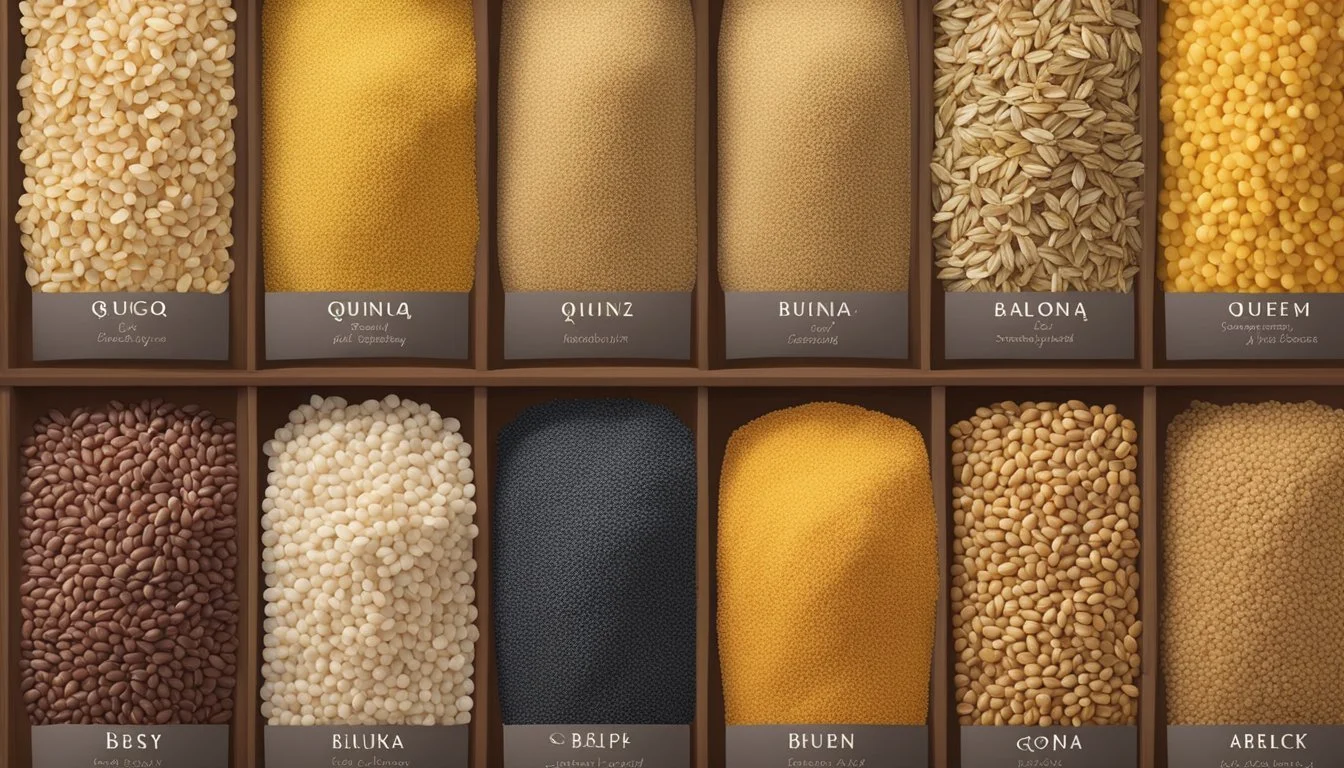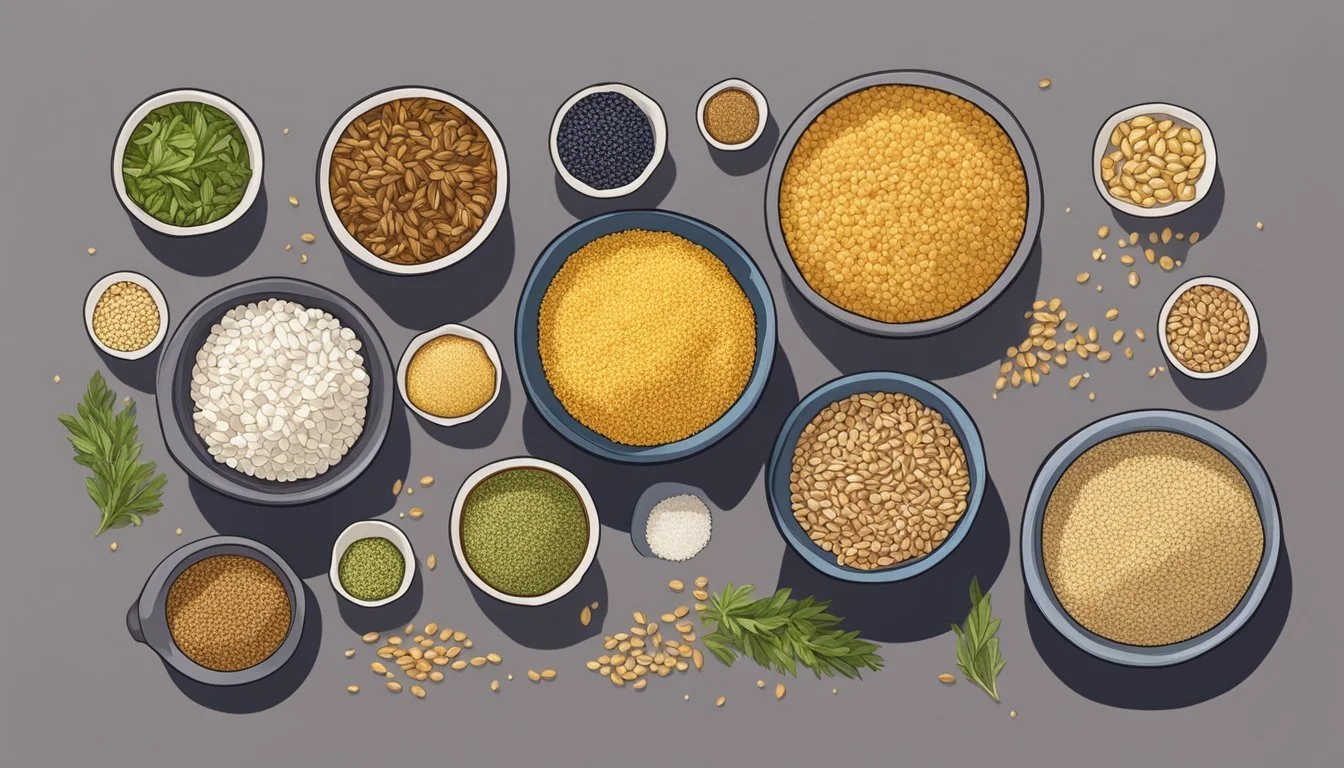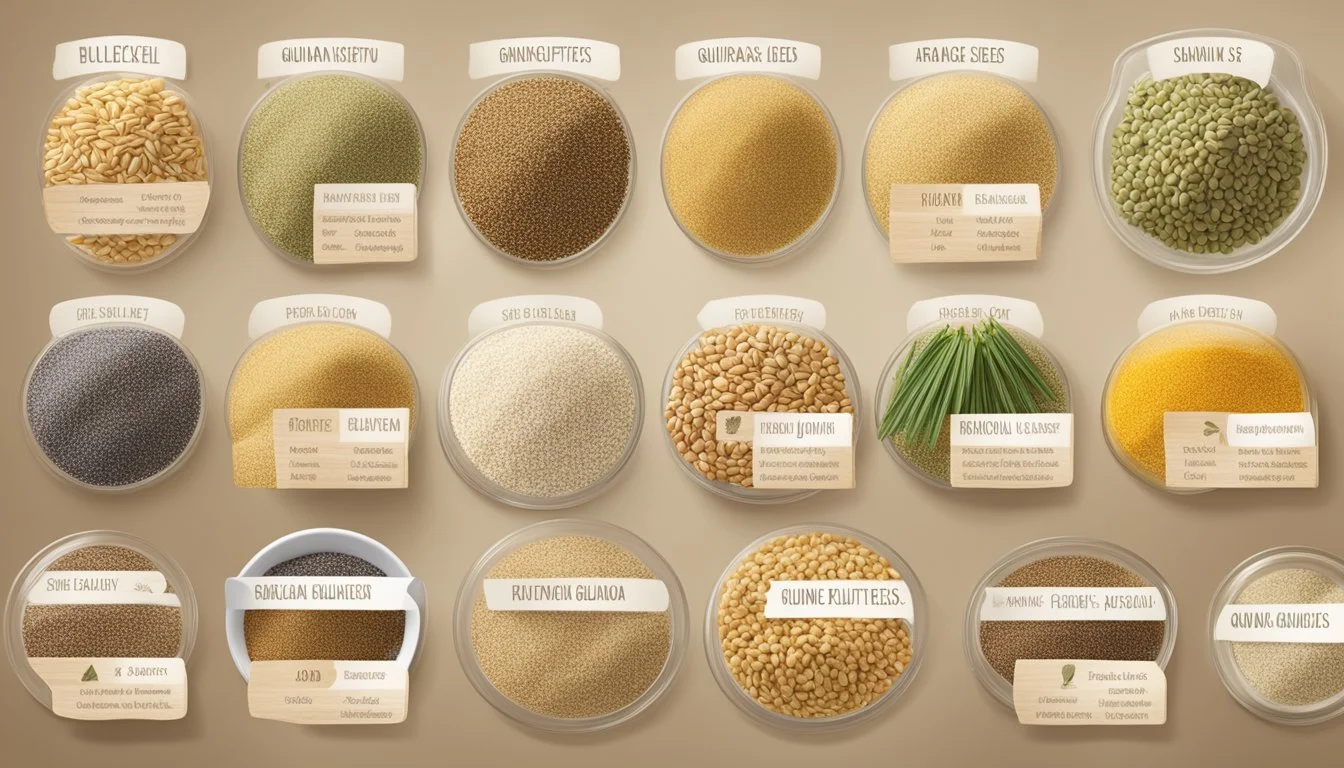Freekeh Substitutes
Best Alternatives for Cooking and Nutrition
Freekeh, an ancient grain originating from the Middle East, is made from green durum wheat that is harvested while still young, roasted, and then threshed to reveal its unique flavor and texture. While freekeh has gained popularity for its nutritional benefits and its distinct nutty taste, it may not always be readily available in all kitchens. For those looking for alternatives, excellent substitutes for freekeh include farro, bulgur, barley, whole wheat couscous, and quinoa.
Each of these grains offers a comparable texture and flavor profile. Farro and barley provide a chewy texture that mimics freekeh's bite, while bulgur and couscous offer similar versatility in various dishes. Quinoa stands out for its nutty taste and fluffiness, making it a popular and nutritious gluten-free substitute.
Incorporating these substitutes into recipes like salads, soups, and stir-fries ensures that the nutritional benefits and culinary charm of freekeh are preserved. Experimenting with these grains can add variety to meals and make it easy to enjoy the flavors and textures associated with freekeh, even when it's not available.
Understanding Freekeh
Freekeh is an ancient grain with a distinct nutty and smoky flavor, originally hailing from the Middle East. It is known for its rich nutritional profile, offering a good source of protein, fiber, and essential minerals and vitamins. It is also versatile in culinary applications such as salads, grain bowls, and stews.
Origin and History
Freekeh, an ancient grain, has origins deeply rooted in the Middle East. Historical records suggest that it has been harvested for over 2,000 years. The name "freekeh" comes from the Arabic word "farīk," which means "rubbed." This refers to the process of roasting and rubbing immature, green wheat to create freekeh.
It was traditionally a staple in Middle Eastern diets, particularly in countries like Jordan, Egypt, and Lebanon. Originally, farmers discovered freekeh accidentally when some of their wheat fields caught fire early in harvest. Instead of discarding the burned wheat, they found that it could be salvaged and had developed a unique nutty and smoky flavor.
Nutritional Profile
Freekeh is celebrated for its robust nutritional benefits. This grain is notably high in protein, containing more than most other grains. It also has a substantial amount of dietary fiber, contributing to digestive health. A typical serving of freekeh provides significant amounts of magnesium, iron, and zinc.
The grain is composed of complex carbohydrates, providing sustained energy release, making it a preferred option for athletes and health-conscious individuals. Freekeh is also rich in vitamins, especially B-complex vitamins, which support metabolism and energy production. Due to its low glycemic index, it helps in maintaining stable blood sugar levels.
Culinary Uses
Freekeh's nutty and smoky flavor makes it a versatile ingredient in various dishes. It is commonly used in Middle Eastern cuisine and can be incorporated into modern recipes with ease. In salads, freekeh adds both texture and flavor, often paired with fresh herbs and citrus-based dressings.
In grain bowls, it serves as a hearty base, complementing vegetables, proteins, and sauces. Freekeh is also a common ingredient in stews and soups, where it absorbs flavors from broths and seasonings. Additionally, it can be used as a pilaf or a side dish, providing a nutritious and flavorful alternative to rice or quinoa.
Freekeh Substitutes Overview
Substitutes for freekeh offer various textures, flavors, and nutritional benefits, making them versatile in different dishes. This section explores essential factors to consider and highlights popular alternatives.
Factors to Consider
When choosing a substitute for freekeh, several factors play a critical role. Texture and flavor are primary considerations, as they significantly impact the dish's overall quality. Freekeh has a slightly nutty and earthy taste, complemented by a chewy texture.
Nutritional value is another important factor. Freekeh is high in fiber and protein, appealing to those on a health-conscious diet. Cooking time also matters; you'll want a grain that fits your schedule. Some grains cook faster than others, which can be convenient for quick meals.
Finally, dietary restrictions such as gluten intolerance should be considered. For instance, while freekeh contains gluten, grains like quinoa and brown rice are excellent gluten-free options.
Popular Freekeh Alternatives
Quinoa
Quinoa is a top choice for replacing freekeh due to its similar texture and slight nutty flavor. It's a complete protein, offering all essential amino acids, making it highly nutritious. Quinoa is also gluten-free, appealing to those with dietary restrictions.
Bulgur
Bulgur shares a similar chewy texture and nutty flavor with freekeh. It's made from cracked wheat, cooks quickly, and is rich in fiber. It's suitable for various dishes, from salads to stews.
Farro
Farro is another great substitute, known for its chewy texture and mild nutty flavor. It’s high in protein and fiber, making it a nutritious choice. Farro's cooking time is relatively short, making it convenient for busy schedules.
Barley
Barley offers a chewy texture and mild flavor, similar to freekeh. It's rich in fiber and essential nutrients. Barley requires a longer cooking time, but its nutritional benefits make it worthwhile.
Brown Rice
Brown rice is a versatile substitute, offering a chewy texture and subtle flavor. It's gluten-free and packed with nutrients, including magnesium and B vitamins. While it may take longer to cook, its health benefits are significant.
Substitute Details
Choosing the right substitute for freekeh depends on the dish you are preparing and your dietary preferences. Below, we will explore some excellent alternatives, focusing on their key characteristics, nutritional content, and ideal uses.
Quinoa
Quinoa is a gluten-free grain known for its versatility and high protein content. Originating from the Andean region, it has become a staple in many diets due to its complete protein profile, containing all nine essential amino acids.
Cooking quinoa is straightforward: rinse thoroughly and simmer in a 2:1 water to quinoa ratio for about 15 minutes. Quinoa’s fluffy, slightly nutty texture makes it suitable for salads, soups, and stir-fries.
Nutritionally, quinoa is rich in fiber, iron, and magnesium. This grain is an excellent choice for those seeking a nutritious, easy-to-prepare alternative to freekeh.
Bulgur Wheat
Bulgur wheat, an ancient grain, is pre-cooked and dried, making it a quick-cooking option. Originating from the Mediterranean, it is commonly used in dishes like tabbouleh.
It requires minimal cooking time—soak bulgur wheat in boiling water for about 10-15 minutes. Its nutty flavor and slightly chewy texture make it ideal for salads, pilafs, and soups.
Bulgur is high in fiber and protein, promoting digestive health and providing sustained energy. It is not gluten-free but remains a nutritious choice for those not restricted by gluten.
Farro
Farro is another ancient grain, popular in Italian cuisine. It has a chewy texture and nutty taste, making it a great substitute in hearty dishes.
Cook farro by simmering it in water or broth for about 30 minutes. It absorbs flavors well, making it perfect for soups, stews, and salads.
Nutritionally, farro offers a good amount of fiber, protein, and essential minerals like magnesium and zinc. It is not suitable for gluten-free diets but provides a wholesome, nutrient-dense alternative to freekeh.
Barley
Barley is known for its rich, chewy texture and is often used in soups and stews. It is a whole grain with a slightly malty flavor that can enhance various dishes.
To cook barley, simmer it in water or broth for about 40-50 minutes. Its texture holds up well in long cooking processes, making it ideal for winter soups and grain bowls.
Barley is packed with fiber, which promotes heart health, and contains essential nutrients like vitamins and minerals. Although not gluten-free, it remains a hearty and nutritious alternative to freekeh.
Brown Rice
Brown rice is a whole grain with a chewy texture, making it a good substitute. It is widely available and can be used in various recipes.
Cook brown rice by simmering it in water for about 45 minutes. Its versatility allows it to be used in stir-fries, casseroles, and side dishes.
Nutritionally, brown rice provides fiber, vitamins, and minerals, supporting overall health and digestion. It is gluten-free, making it suitable for those with gluten sensitivities or celiac disease.
Specialty Substitutes
Freekeh is a versatile grain, but when it's not available, there are several specialty substitutes that can fit various dietary needs and offer unique flavors. This section explores three categories: gluten-free options, nutrient-dense alternatives, and substitutes with unique flavors.
Gluten-Free Options
Freekeh contains gluten, so it's essential to have gluten-free alternatives for those who need them. Quinoa is a top choice due to its nutty taste and fluffy texture. It is also a complete protein, providing all nine essential amino acids.
Brown Rice is another excellent substitute with a chewy grain texture. It works well in pilafs and salads. Amaranth and Millet offer unique textures and are high in nutrients like magnesium and calcium. These options provide the versatility needed for various recipes while maintaining a gluten-free diet.
Nutrient-Dense Alternatives
For those seeking nutrient-dense alternatives, options like Quinoa, Amaranth, and Millet stand out. Quinoa is rich in protein and fiber, making it an excellent addition to salads and main dishes. Its nutritional profile includes magnesium, iron, and B-vitamins.
Amaranth offers a slightly nutty flavor and is packed with protein, calcium, and iron. Millet is another nutrient-dense choice, known for its high magnesium content and versatility in both sweet and savory dishes. These grains not only replace freekeh well but also enhance the nutritional value of meals.
Unique Flavor Substitutes
Unique flavor substitutes can add a distinct taste to dishes. Barley offers a hearty, nutty flavor, enhancing soups and stews. Farro has a chewy texture and rustic taste that works well in salads and grain bowls.
Bulgur Wheat is slightly milder but complements spices and herbs like garlic and parsley beautifully. These substitutes bring unique flavors and textures to recipes, making them stand out even without freekeh. By experimenting with various combinations, one can discover new culinary possibilities and flavors.
Health and Dietary Considerations
Freekeh is celebrated for its numerous health benefits, from aiding in weight management to supporting heart health. It is rich in fiber, protein, and essential minerals such as magnesium and potassium.
Weight Management
Freekeh's high fiber content plays a crucial role in weight management. Fiber promotes satiety, which helps reduce overall calorie intake by keeping individuals fuller for longer periods. This is particularly beneficial for those aiming for weight loss or maintaining a healthy weight.
Moreover, freekeh has a low glycemic index, which means it releases glucose slowly into the bloodstream. This prevents spikes in blood sugar levels, aiding in appetite control and preventing unhealthy snacking.
Freekeh is also rich in protein, which requires more energy to digest compared to carbohydrates or fats, thus burning more calories in the process. It provides a balanced mix of fiber and protein, making it an excellent choice for those looking to manage their weight effectively.
Heart Health Benefits
Freekeh contributes significantly to heart health due to its nutritional profile. The fiber content helps in reducing levels of bad cholesterol (LDL), thus lowering the risk of cardiovascular diseases. Regular consumption of high-fiber foods like freekeh is linked to better heart function and reduced arterial plaque build-up.
Magnesium and potassium found in freekeh are essential for healthy heart function. Magnesium helps in maintaining a steady heartbeat, while potassium aids in blood pressure regulation. These minerals work together to ensure that the heart muscles function efficiently and effectively.
Furthermore, the low glycemic index of freekeh supports stable blood sugar levels, which is crucial in preventing diabetes-related heart complications. Thus, incorporating freekeh into the diet can be a strategic way to boost heart health through natural means.
Preparing and Cooking Alternatives
Substitutes for freekeh, such as quinoa, farro, barley, bulgur wheat, and brown rice, offer a wide range of flavors and textures. Each alternative requires specific preparation and cooking methods to maximize taste and nutrition.
Cooking Techniques
Quinoa: Rinse well to remove its bitter saponin coating. Use two cups of water for every cup of quinoa, bring to a boil, then simmer for 15-20 minutes until tender. Farro: Soak overnight to reduce cooking time. Boil with a 3-to-1 water ratio for about 30 minutes until chewy. Barley: Usually requires no soaking. Boil with 3 cups of water per cup of barley for 40-50 minutes.
Bulgur Wheat: Quick and easy; just soak in boiling water (1:1 ratio) for 20 minutes. Brown Rice: Requires a 2-to-1 water ratio, bring to a boil, then simmer for about 45 minutes until tender.
Recipe Adaptations
Freekeh substitutes can adapt to various dishes, ensuring delicious results. Quinoa fits well in salads, grain bowls, and casseroles, offering a mild and nutty flavor. Farro works excellently in pilaf and porridge due to its chewy texture. Barley is perfect for hearty stews and soups, giving a rich, dense texture.
Bulgur Wheat suits quick dishes like tabbouleh and can replace freekeh in grain salads. Brown Rice offers versatility in porridges, stir-fries, and casseroles, delivering a slightly chewy consistency. Adjust cooking times and liquid ratios based on the recipe requirements to achieve the desired texture and flavor.
Flavor Pairings
Freekeh substitutes pair well with a variety of vegetables, spices, and herbs. Quinoa pairs excellently with bell peppers, onions, and fresh herbs like cilantro and parsley. Add spices such as cumin and paprika to enhance its flavor. Farro complements root vegetables, mushrooms, and rich broths, absorbing flavors deeply.
Barley pairs well with hearty vegetables like carrots and potatoes, along with robust spices like bay leaves and thyme. Bulgur Wheat is ideal with acidic ingredients like tomatoes and lemon juice, and herbs like mint. Brown Rice is versatile, pairing well with a broad range of vegetables, from bell peppers to snap peas, and spices like garlic and ginger. Enhance with broth for added richness.
Shopping for Substitutes
When shopping for substitutes for freekeh, it's essential to know which stores carry these alternatives and how to identify the right grains. This guidance makes the shopping experience more efficient and ensures you get the best substitutes available.
Finding Alternatives at Stores
Finding grains and substitutes in supermarkets is quite straightforward. Large chain stores like Walmart and Target generally offer a wider selection. Look in the grains or health food aisles for items such as quinoa, farro, and barley.
Local grocery stores may have a smaller selection. Visit the bulk bins section for options like bulgur and brown rice. Whole wheat couscous and parboiled rice are often found in the ethnic food aisles or near rice products.
When shopping, it’s helpful to check for organic or non-GMO labels if you prefer those options. Additionally, dried and packaged forms often have a longer shelf life and are easy to store.
Identifying Whole Grains
Understanding which grains are whole or refined is crucial for making healthy choices. Whole grains retain the bran and germ, offering more nutrients and fiber. Examples include whole grain quinoa, pearled barley, and kamut. These grains are more nutritious than their refined counterparts.
Refined grains have the bran and germ removed, reducing certain nutrients. Items like white rice and processed couscous fall into this category. Look for packages labeled as "whole" to ensure you are purchasing nutritious grains.
Cracked and parboiled grains are also beneficial. Freekeh itself is cracked and dried, so substitutes like cracked wheat or parboiled rice closely match its texture and cooking time.
Selecting these grains requires paying attention to labels and understanding the differences between whole and refined options. This knowledge helps in choosing the healthiest and most suitable substitutes for freekeh.
Recipes and Serving Suggestions
Freekeh substitutes can be used in various recipes, offering ample flexibility in both flavor and texture. These substitutes work well in breakfast dishes, salads, side dishes, and more substantial main courses.
Breakfast Options
Quinoa, amaranth, and millet are excellent choices for morning meals. They can be used to create a breakfast porridge rich in protein and fiber. Cook these grains with milk or a milk alternative and sweeten with honey or maple syrup. Add fruits, nuts, and a sprinkle of cinnamon for added flavor and nutrition.
Example Recipe:
Ingredients: 1 cup quinoa, 2 cups milk, 1 tbsp honey, 1 tsp cinnamon, fruits and nuts as preferred.
Directions: Cook quinoa in milk for 15 minutes. Stir in honey and cinnamon. Top with fruits and nuts.
Salads and Side Dishes
Farro and bulgur are great for cold salads such as a freekeh salad or traditional tabbouleh. Both grains soak up dressings well and maintain a pleasant chewiness. Combine cooked farro or bulgur with chopped herbs, tomatoes, cucumbers, and a lemon-olive oil dressing.
Example Recipe:
Ingredients: 1 cup farro, 1 cup chopped parsley, 1/2 cup chopped tomatoes, 1/2 cup chopped cucumbers, 1/4 cup lemon juice, 2 tbsp olive oil.
Directions: Cook farro as per package instructions. Mix all ingredients in a bowl and toss with lemon juice and olive oil.
Main Courses and Hearty Meals
For more substantial dishes, brown rice, barley, and whole wheat couscous are suitable. These grains can be used in stews, pilafs, and casseroles. Try a barley and vegetable stew or a quinoa-stuffed bell pepper for a nutritious and filling dinner. These grains complement hearty flavors and can absorb rich broths and sauces well.
Example Recipe:
Ingredients: 1 cup barley, 2 cups vegetable broth, assorted vegetables (carrots, celery, onions), 2 tbsp tomato paste, 1 tsp paprika.
Directions: Simmer barley in vegetable broth with chopped vegetables, tomato paste, and paprika until barley is tender. Adjust seasoning to taste.







